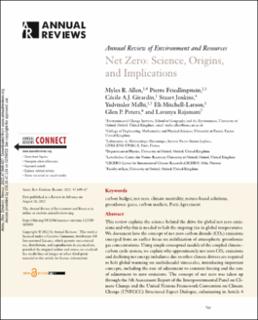| dc.contributor.author | Allen, Myles R. | |
| dc.contributor.author | Friedlingstein, Pierre | |
| dc.contributor.author | Girardin, Cécile A.J. | |
| dc.contributor.author | Jenkins, Stuart | |
| dc.contributor.author | Malhi, Yadvinder | |
| dc.contributor.author | Mitchell-Larson, Eli | |
| dc.contributor.author | Peters, Glen Philip | |
| dc.contributor.author | Rajamani, Lavanya | |
| dc.date.accessioned | 2024-02-20T08:50:39Z | |
| dc.date.available | 2024-02-20T08:50:39Z | |
| dc.date.created | 2022-12-07T11:24:38Z | |
| dc.date.issued | 2022 | |
| dc.identifier.citation | Annual Review Environment and Resources. 2022, 47 849-887. | en_US |
| dc.identifier.issn | 1543-5938 | |
| dc.identifier.uri | https://hdl.handle.net/11250/3118584 | |
| dc.description.abstract | This review explains the science behind the drive for global net zero emissions and why this is needed to halt the ongoing rise in global temperatures. We document how the concept of net zero carbon dioxide (CO2) emissions emerged from an earlier focus on stabilization of atmospheric greenhouse gas concentrations. Using simple conceptual models of the coupled climate–carbon cycle system, we explain why approximately net zero CO2 emissions and declining net energy imbalance due to other climate drivers are required to halt global warming on multidecadal timescales, introducing important concepts, including the rate of adjustment to constant forcing and the rate of adjustment to zero emissions. The concept of net zero was taken up through the 5th Assessment Report of the Intergovernmental Panel on Climate Change and the United Nations Framework Convention on Climate Change (UNFCCC) Structured Expert Dialogue, culminating in Article 4of the 2015 Paris Agreement. Increasing numbers of net zero targets have since been adopted by countries, cities, corporations, and investors. The degree to which any entity can claim to have achieved net zero while continuing to rely on distinct removals to compensate for ongoing emissions is at the heart of current debates over carbon markets and offsetting both inside and outside the UNFCCC. We argue that what matters here is not the precise makeup of a basket of emissions and removals at any given point in time, but the sustainability of a net zero strategy as a whole and its implications for global temperature over multidecadal timescales. Durable, climate-neutral net zero strategies require like-for-like balancing of anthropogenic greenhouse gas sources and sinks in terms of both origin (biogenic versus geological) and gas lifetime. | en_US |
| dc.language.iso | eng | en_US |
| dc.publisher | Annual Review | en_US |
| dc.rights | Navngivelse 4.0 Internasjonal | * |
| dc.rights.uri | http://creativecommons.org/licenses/by/4.0/deed.no | * |
| dc.subject | carbon budget | en_US |
| dc.subject | net zero | en_US |
| dc.subject | climate neutrality | en_US |
| dc.subject | nature-based solutions | en_US |
| dc.subject | greenhouse gases | en_US |
| dc.subject | carbon markets | en_US |
| dc.subject | Paris Agreement | en_US |
| dc.title | Net Zero: Science, Origins, and Implications | en_US |
| dc.title.alternative | Net Zero: Science, Origins, and Implications | en_US |
| dc.type | Peer reviewed | en_US |
| dc.type | Journal article | en_US |
| dc.description.version | publishedVersion | en_US |
| dc.source.pagenumber | 849-887 | en_US |
| dc.source.volume | 47 | en_US |
| dc.source.journal | Annual Review Environment and Resources | en_US |
| dc.identifier.doi | 10.1146/annurev-environ-112320-105050 | |
| dc.identifier.cristin | 2089982 | |
| dc.relation.project | EC/H2020/820846 | en_US |
| dc.relation.project | EC/H2020/869192 | en_US |
| dc.relation.project | EC/H2020/821205 | en_US |
| dc.relation.project | EC/H2020/821003 | en_US |
| cristin.ispublished | true | |
| cristin.fulltext | original | |
| cristin.qualitycode | 1 | |

